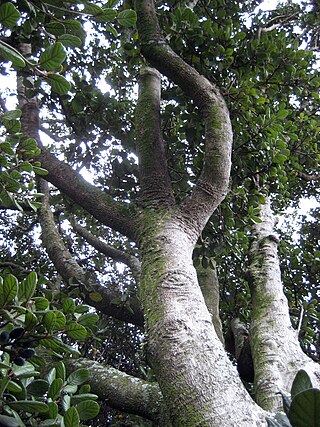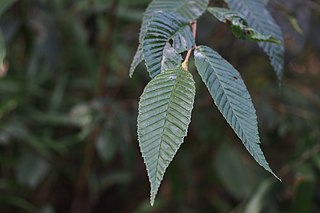
Betula pendula, commonly known as silver birch, warty birch, European white birch, or East Asian white birch, is a species of tree in the family Betulaceae, native to Europe and parts of Asia, though in southern Europe, it is only found at higher altitudes. Its range extends into Siberia, China, and southwest Asia in the mountains of northern Turkey, the Caucasus, and northern Iran. It has been introduced into North America, where it is known as the European white birch or weeping birch and is considered invasive in some states in the United States and parts of Canada. The tree can also be found in more temperate regions of Australia.

Beilschmiedia tawa, the tawa, is a New Zealand broadleaf tree common in the central parts of the country. Tawa is often the dominant canopy tree species in lowland forests in the North Island and the north east of the South Island, but will also often form the subcanopy in primary forests throughout the country in these areas, beneath podocarps such as kahikatea, matai, miro and rimu. Individual specimens may grow up to 30 metres or more in height with trunks up to 1.2 metres in diameter, and they have smooth dark bark. The Māori word "tawa" is the name for the tree.

Pyrus salicifolia is a species of pear, native to the Middle East. It is widely grown as an ornamental tree, almost always as a pendulous cultivar, and is called by various common names, including willow-leaved pear, weeping pear, and similar. The tree is deciduous and of comparatively small stature, rarely reaching 10–12 meters in height. The crown is rounded. It has pendulous, silvery foliage, superficially similar to a weeping willow. The flowers are large and pure white highlighted with black-tipped stamens although the buds are tipped with red. The small green fruits are inedible, being hard and astringent.

Beilschmiedia tarairi, commonly called taraire, is a tree of the family Lauraceae, endemic to the North Island of New Zealand. It is a common canopy tree in lowland forests north of Auckland, often growing in association with kauri, pōhutukawa, tawāpou, and pūriri on basalt rocks and soils. Beilschmiedia is a genus of about 40 mainly tropical trees and shrubs with alternate to opposite leaves.
Beilschmiedia ambigua is a species of plant in the family Lauraceae. It is endemic to the Democratic Republic of the Congo. It is threatened by habitat loss.

Beilschmiedia is a genus of trees and shrubs in family Lauraceae. Most of its species grow in tropical climates, but a few of them are native to temperate regions, and they are widespread in tropical Asia, Africa, Madagascar, Australia, New Zealand, North America, Central America, the Caribbean, and South America. The best-known species to gardeners in temperate areas are B. berteroana and B. miersii because of their frost tolerance. Seeds of B. bancroftii were used as a source of food by Australian Aborigines. Timbers of some species are very valuable.
Beilschmiedia bracteata is a species of plant in the family Lauraceae. It is endemic to the Democratic Republic of the Congo. It is threatened by habitat loss.
Beilschmiedia insignis is a species of plant in the family Lauraceae. It is a tree endemic to Peninsular Malaysia.
Beilschmiedia mayumbensis is a species of plant in the family Lauraceae. It is endemic to the Democratic Republic of the Congo. It is threatened by habitat loss.
Beilschmiedia membranacea is a species of plant in the family Lauraceae. It is a tree endemic to Peninsular Malaysia. As of May 2017, it was classified as "vulnerable" by the IUCN Red List and is believed to be in Taman Negara
Beilschmiedia penangiana is a species of plant in the family Lauraceae. It is a tree endemic to Peninsular Malaysia. It is threatened by habitat loss.
Beilschmiedia preussii is a species of plant in the family Lauraceae. It is endemic to Cameroon. Its natural habitat is subtropical or tropical dry forests. It is threatened by habitat loss.

Beilschmiedia berteroana is a threatened evergreen tree in the family Lauraceae endemic to Chile at 35 to 37°S.
Beilschmiedia bancroftii is a tree species in the family Lauraceae. It is native to Queensland in Australia. Common names include yellow walnut, yellow nut and canary ash.
Beilschmiedia gaboonensis is an evergreen tree in the subgenus Hufelandia of the genus Beilschmiedia, in the family Lauraceae. It is native to central Africa. It is a medium-sized tree which can measure up to 30 m tall with a bole diameter of up to 60 cm. It is distributed from southern Nigeria to the Congo basin, occurring in Cameroon, Gabon and Zaïre. It is associated with marshy locations in lowland rainforest. Similarly to Beilschmiedia mannii, it is known under the trade names "kanda" and "pink kanda". The bark is used in analgesic and healing ointments.
Beilschmiedia roxburghiana is the type species of the tree genus Beilschmiedia in the family Lauraceae. Its native range is from the Himalayas to S. China, Indo-China to Peninsula Malaysia; in Vietnam it may be called chắp chại or bạch mi; no subspecies are listed in the Catalogue of Life.
Beilschmiedia micrantha is a species of tree in the laurel family (Lauraceae). It is endemic to Borneo. It is a large tree which grows up to 40 metres tall. It flowers from April to July, and September and October, and fruits in July and October.
Maillardia montana, synonyms including Maillardia pendula, is a species of flowering plant in the family Moraceae, native to Mayotte, the Aldabras, and Madagascar in the western Indian Ocean. It was first described by Jacques Désiré Leandri in 1948.
Beilschmiedia lucidula is a widespread species of flowering plant in the family Lauraceae, native to the eastern Indian Subcontinent, Indochina, and most of Malesia. It is a tree reaching 30 m (98 ft) tall.

Alnus pendula is a species of flowering plant in the alder genus Alnus, native to Honshu and Hokkaido islands of Japan. An "exceptionally attractive" and "extremely elegant" large shrub or small tree, sources differ on whether it is introduced or native to Korea.








